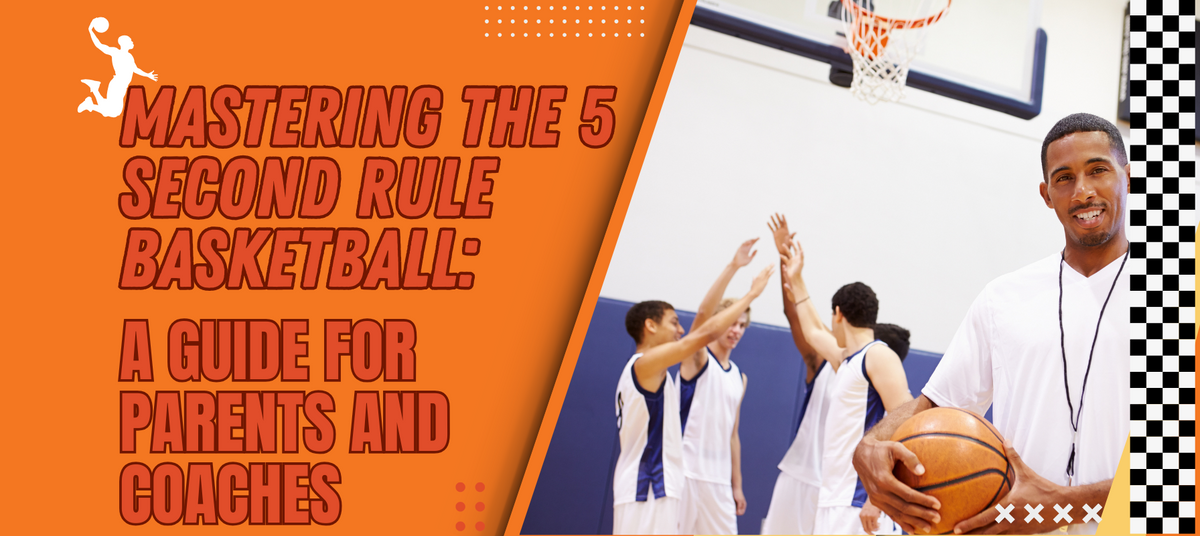
Mastering the 5 Second Rule Basketball: A Guide for Parents and Coaches
|
|
Time to read 5 min
|
|
Time to read 5 min
As a basketball parent, you want your child to understand the game. Maybe they're just starting out and need to learn the basics. Or perhaps they've been playing for a while but need help understanding specific rules, like the 5 second rule basketball. You're in the right place – we'll break down this sometimes confusing rule and explore how it keeps the game fair and exciting.
In basketball, the 5-second violation rule is all about keeping the game moving and preventing stalling. It applies in two main scenarios, both of which put the offensive team on the clock. This rule encourages quick thinking and skillful play from all players on the court.
Imagine the ball has gone out of bounds. A player from the team who didn’t touch it last gets ready to throw it back in.
The moment they have possession, the referee starts a mental clock, and they have just five seconds. This rule, as defined by the International Basketball Federation, ensures that teams can’t just hold onto the ball after it goes out of bounds.
Now, picture a player with the ball in their hands, being closely guarded by an opponent. In this situation, the 5 second rule basketball violation prevents them from just holding onto the ball indefinitely.
They need to make a decision quickly – shoot, pass, or dribble. If they don't take one of these actions within five seconds, a violation will be called.
The 5 second violation rule has variations depending on the level of play - high school, college, or professional. For instance, in college basketball, there's a distinction in the 'closely guarded' scenario.
A count can be initiated only when the ball is in the offensive player’s hands and not while dribbling. Whereas, in high school, the five seconds can be applied in both situations. Understanding these nuances can help players avoid frustrating turnovers and penalties.
But what happens if a player accidentally breaks the 5-second rule? Simple - the referee blows the whistle, and the result is a turnover.
The other team gains possession. In the case of a throw-in violation, they’ll inbound the ball from the sideline. This emphasizes the importance of being alert and decisive when handling the ball. It can be frustrating for players and fans alike, especially if it occurs during a crucial moment of a close game.
Coaches and parents play a crucial role in ensuring young players fully grasp and consistently apply their understanding of the 5-second rule in basketball. So how can we effectively teach them to avoid those game-changing violations?
One effective method is to incorporate specific drills into practice sessions that simulate game-like situations involving inbounding and closely guarded scenarios. These drills can include:
By repeatedly practicing these scenarios, players develop muscle memory, allowing them to react instinctively under pressure. This builds confidence in their abilities.
Encouraging young players to consistently maintain awareness on the court can also significantly reduce violations. Remind them of these essential awareness points:
Effective communication is another critical factor in minimizing five-second violations:
Beyond physical skills and drills, a significant component of mastering the five-second rule lies in the mental approach to the game:
These examples highlight the importance of promoting a holistic understanding and application of the rule.
A 5-second violation happens when an offensive player with the ball doesn't shoot, pass, or dribble within five seconds. It can happen in two ways: if a defender is closely guarding them, or during a throw-in after the ball goes out of bounds. This rule exists to keep the game moving and prevent stalling.
Generally, you can hold a basketball for five seconds without dribbling, but this can change depending on the level of play and the specific situation. For example, in college basketball, you can't be closely guarded and hold the ball for more than five seconds without dribbling, passing, or shooting.
It’s important to note that in basketball, the correct terminology is 'five-second violation', not the 'five-second rule.' This term distinguishes it from a completely unrelated and unsanitary (but widely known) 'five-second rule' that suggests food dropped on the floor is still okay to eat if picked up within five seconds.
That’s not entirely true; the five-second violation rule does exist in college basketball, but there are some differences compared to other levels of play. For instance, the five-second closely guarded violation only applies when a player is holding the ball, not dribbling. It is always best to consult the rule book for the specific level of play to get clarification.
The 5-second rule in basketball is a key element for balancing offense and defense, helping players avoid turnovers and fostering continuous, dynamic gameplay. Mastering this rule contributes to team success and enhances the game's overall flow. However, it's important to recognize that understanding this rule is just one aspect of the broader basketball experience.
Players, coaches, and parents alike should encourage the development of fundamental skills, good sportsmanship, and respect for the rules. This helps young athletes reach their potential in basketball and promotes fair play and the development of valuable life skills along the way.
5 Second Rule Basketball. 5 Second Rule Basketball. 5 Second Rule Basketball. 5 Second Rule Basketball. 5 Second Rule Basketball.5 Second Rule Basketball. 5 Second Rule Basketball.5 Second Rule Basketball. 5 Second Rule Basketball.5 Second Rule Basketball. 5 Second Rule Basketball.5 Second Rule Basketball. 5 Second Rule Basketball.5 Second Rule Basketball. 5 Second Rule Basketball.5 Second Rule Basketball. 5 Second Rule Basketball.5 Second Rule Basketball. 5 Second Rule Basketball.5 Second Rule Basketball. 5 Second Rule Basketball.5 Second Rule Basketball. 5 Second Rule Basketball.5 Second Rule Basketball. 5 Second Rule Basketball.
This site requires cookies in order to provide all of its functionality.
